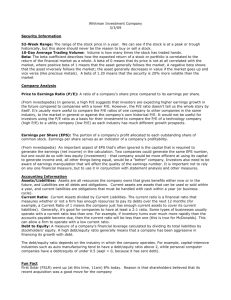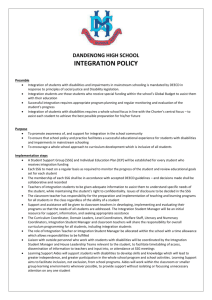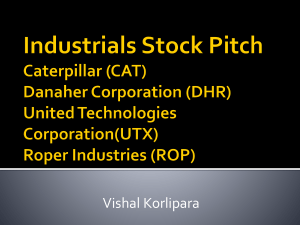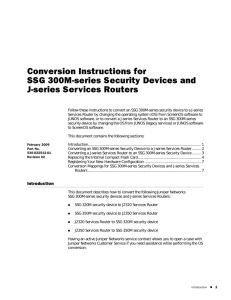one page quick analysis of a stock
advertisement
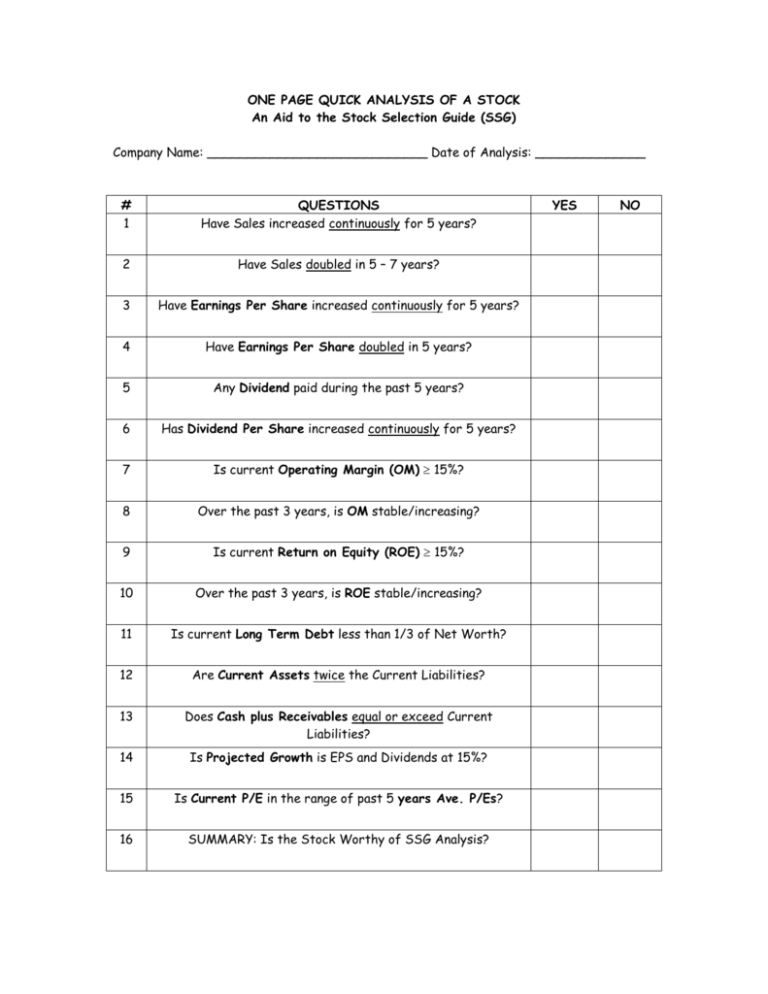
ONE PAGE QUICK ANALYSIS OF A STOCK An Aid to the Stock Selection Guide (SSG) Company Name: ____________________________ Date of Analysis: ______________ # 1 QUESTIONS Have Sales increased continuously for 5 years? 2 Have Sales doubled in 5 – 7 years? 3 Have Earnings Per Share increased continuously for 5 years? 4 Have Earnings Per Share doubled in 5 years? 5 Any Dividend paid during the past 5 years? 6 Has Dividend Per Share increased continuously for 5 years? 7 Is current Operating Margin (OM) 15%? 8 Over the past 3 years, is OM stable/increasing? 9 Is current Return on Equity (ROE) 15%? 10 Over the past 3 years, is ROE stable/increasing? 11 Is current Long Term Debt less than 1/3 of Net Worth? 12 Are Current Assets twice the Current Liabilities? 13 Does Cash plus Receivables equal or exceed Current Liabilities? 14 Is Projected Growth is EPS and Dividends at 15%? 15 Is Current P/E in the range of past 5 years Ave. P/Es? 16 SUMMARY: Is the Stock Worthy of SSG Analysis? YES NO ONE PAGE QUICK ANALYSIS OF A STOCK An Aid to the Stock Selection Guide (SSG) By Kaush Meisheri, Ph. D. Kalamazzo, MI. The sole purpose of this quick analysis is to identify excellent companies worthy of an SSG analysis, and the ones that are more likely to “pass” the SSG analysis. The Quick Analysis, by definition, is focused on a qualitative appraisal of a stock worthy of investment, with the idea that a quantitative analysis would follow by using SSG. In short, no calculators, no rulers, no colored pencils and no computers! I imagined this as a sheet someone could take to the public library and while going through the current Value Line, use to select companies of further interest. The Quick Analysis is developed as a series of questions that can be answered in a “yes” or “no” fashion, with all answers derived from the Value Line report. In the following section, I will present the Quick Analysis rationale behind each question. The questionnaire is designed to address four basic attributes of a stock worthy of serious investment consideration: 1. Is the company profitable and productive, showing consistent records? (Questions 1-6) 2. Is the management’s handling of business and finances superior? (Questions 7-13) 3. Is the company’s future growth rate attractive? (Question 14) 4. Is the stock selling at a price that might be in the buy range? (Question 15) Detailed discussion of questions: Question 1 The first question addresses the productivity record of a company. Does the company sell products that consumers want to buy? In the first question, we are looking at the most recent five-year history since in most cases; a five-year period can represent a reasonable business and economic cycle. If a company has managed, for five years in a row, to increase its sales each year over the previous year, this would be the first indication that the company has worthwhile products and has managed to remain productive. Question 2 The second question gives us a quick idea of the rate of sales growth. A basic characteristic I look for in growth stock is growth at a rate of 15 percent per year, meaning that the company would have doubled its sales in the past five-year period (this would be somewhat less than 15 percent, but close enough). For large companies (annual sales of about $4 billion or more), a sales growth rate of roughly 10 percent (meaning doubling of sales in seven years) would still be respectable. Thus, we are looking for companies that have at least doubled their sales in the five to seven-year period. Helpful Hint: For compound growth rates, it is helpful to remember that tripling in five years would roughly represent a compound growth rate of 25 percent a year; doubling in five years equals about 17 percent; and doubling in seven years equals about 11 percent.) Question 3 This question addresses the profitability record of the company. Has the company managed to be continuously profitable? Again, we are looking for companies that have uninterrupted increases in Earnings Per Share (EPS) in the past five years. Question 4 This question addresses the rate of earnings growth. We are looking for a company that has at least doubled its EPS in the past five years, indicating a minimum of about a 15 percent annual growth rate of profits. Hint: If the answers to the first four questions are all clearly negative, we could stop the analysis since it is quite unlikely that the company is worthy of further consideration based on the fundamentals. Uninterrupted growth in sales as well as earnings at respectable rates are the cornerstone of solid investment selections, and a true-blue fundamental investor should be very reluctant to compromise in these criteria. Finally, it should be noted that the companies with less than five years of documented history of sales and earnings would not be included in such an analysis. In fact, SSG analysis encourages us to plot the past 10 years sales and earnings data to help project future growth. We may find high growth companies with less than five years of history that have shown their sales and earnings double (or even triple) in less than a five-year period. However, such companies would carry more risk since they have no proven track record during a variety of different conditions that are experienced during a normal business and economic cycle. Question 5 and 6 These tow questions should be considered optional. A lack of dividend payment in a solid growth company is not necessarily negative (example, Microsoft). However, a small dividend payment that continues to increase in a solid growth company should be considered a definite positive (example, Intel). As a further optional exercise, we could also determine the rate of growth of dividend payments. Question 7 and 8 These two questions deal with the management’s ability to extract profits from the sales of company’s products (i.e., management’s ability to operate the business). Operating income is a pre-tax number and represents the difference between income from goods sold and the cost of making and selling the goods. (Operating income is not the same as the pre-tax profit used in SSG analysis, but for most companies it represents the vast majority of total pre-tax profits.) the operating margin (OM) are threes pre-tax profits expressed as percent of sales. The Value Line report proves Operating Margin. I would consider a 15 percent OM as a respectable target, and a consistent OP of 20 percent over the past three years as superior. Of course, the higher a company’s OM is, compared to its industry competitors, the better. In contrast, if OM has declined three to five percent over the past three years, that should constitute a “yellow flag” for a company, especially when combined with stagnant or eroding sales. Some of the highly successful industry leaders boast eye-popping OMs in the 25 – 50 percent range, including companies such as Coca-Cola, Merck, Microsoft, Intel and Cisco, to name a few. Question 9 and 10 These two questions deal with the management’s ability to enhance return on company’s investments, and represents how well the management can fuel company’s internal growth using shareholders’ money. Value Line reports provides Return on Equity (ROE) as % Earned Net Worth. I consider a stable ROE of 15 percent as respectable and 20 as superior. Some of the highly successful industry leaders that boast tremendous ROEs (30 percent or better) include Coca-Cola, Merck, Gillette, Philip Morris, Microsoft, Intel and Cisco. Question 11, 12 and 13 These three questions deal with the management’s ability to handle long-term as well as day-to-day finances. Long-term debt can be helpful in financing growing businesses. However, too high a debt can be a burden in times of a weak, inflationary economy since high interest payments on the debt could prove to be a drain on earnings. I offer this analogy: long-term debt is like the extra weight carried around by a marathon runner. When the runner is in good shape and full of energy, she doesn’t fell the weight at all. But towards the end of the race when she is drained of energy, this extra weight can feel deadly. As a norm, I don’t think long tem deft should exceed one-third of the net worth of the company. (Note: some investors expand that one-third of total capitalization, i.e. net worth plus long term debt.) Some huge companies are prospering without carrying much or any long-term debt (examples, Microsoft, Intel, Merck). Next, the levers of current assets and cash should be such that day-to-day financial obligations can be met without undue stress. Here are two basic forms for analyzing this: 1. To have current assets that are twice the current liabilities (this is also called Current Ratio). We can ascertain this in two different ways from Value Line. First, that the current assets are greater than the current liabilities. The other way is to see if the working capital is greater than the current liabilities. This works because, working capital, by definition, is current assets minus current liabilities. 2. To have cash and receivables equivalent to current liabilities. (This is also called Quick Ratio.) The company should have enough cash on hand to meet the immediate liability obligations. Value Line also provides an additional two years of history for these numbers for comparison. Question 14 This questions deals with the company’s future growth prospects, since we are interested mainly in companies that are likely to grow at a rat of 15 percent or better. Such companies are likely to fulfill our objective of doubling our investment in five years. Here we rely on the professional analysts’ (such as Value Line’s) understanding of the company, the business and the industry as a whole. We should, however, keep in mind that the future growth estimate scan and do indeed change over time, and thus it is important to obtain analyst’ consensus estimates that are as recent as possible. With the advent o ft he Internet, it should be possible to supplement the Value Line information with the most current data on analysts’ earnings estimates once the stock otherwise looks worthwhile. Question 15 This question is really a proxy for another question we want to ask but can’t, because it is not possible to answer it easily. That question is, “Is the stock in the buy range?” However, here’s a way we can “guesstimate” if the current stock price “might be” in he buy range if we were to do an SSG analysis. (Note: Be careful with this one! Remember, we’re guessing, and we’re guessing using someone else’s estimates and projections. When it comes to answering the buy-range question, there are no shortcuts to a full Stock Selection Guide analysis.) Value Line provides both the current P/E as well as the average annual P/E. In general, if the current P/E (this changes as the price of the stock changes), is within or below the range of the past five years of average annual P/Es, then chances are that the stock price would be in the buy range on an SG, provided that the company’s earnings are projected to grow at the same rate or higher than the past earnings growth. So if your answers to questions 4 and 14 were positive, then a “yes” answer to question 15 would suggest that the stock might be in the buy price range. A current P/E that is higher than the highest average P/E achieved in the past five years would suggest that chances are the stock would not be in the buy range currently on SSG. One approach would be as follows: If all of the 14 questions above have strongly positive answers, then go ahead and do the SSG analysis to determine the buy price range. You could then follow the company and look for an appropriate price at which to buy the stock. Question 16 This summary question is easy to answer if all the answers are positive. We are looking for a company with superior history of sales, earnings and dividend increases, consistently for reasonably long periods (five years or longer), at attractive growth rates (15 percent or better), with highly capable and proven management, and with excellent future growth prospects. Thus, it is clear that a company that appears to be an excellent candidate for long-term investment, especially if the stock can be bought within the buy price range, and thus worthy of a detailed SSG analysis. As pointed out before, if the first four questions result in negative answers, we might want to discard that company and move on to find a better stock. Of course, the more positive answers for a stock, the better selection it is likely to be. We should also be on the lookout for the balance of the positive answers. However, weakness in one or two parameters could be excused in an otherwise excellent corporation (i.e., “look at the whole picture”). For example, even if the answers to the first four questions are highly positive, a declining OM coupled with poor ROE numbers should be a red flag. Or, if a successful company is trying to grow rapidly wit too much debt and very little cash reserves for contingencies, we have reason to be concerned. A solid investment choice is a company that not only grows by selling desirable products profitably, but also has a proven management that is well prepared to meet the unexpected demands f the business. In case of doubt, one should not hesitate to look for companies with more positive answers. In conclusion, I have found this methodology useful in identifying superior corporations, and I am happy to share it with my fellow investors. Actually, the idea of this Q&A list was derived from the original research I carried out during my earlier efforts directed at identifying high quality DRP companies, which I have shared with BI readers. My personal experience has been that using this list of questions has mad me think of various specific aspects of a company’s business, not just what its stock price has done lately. Gradually over time, this Quick Analysis has become a mental checklist when I visit the local library studying weekly Value Line reports. I glance over sales, earnings and dividend histories mentally checking to see if they have grown uninterrupted and if they have at least doubled in the past five years. If I am still interested in the company, then I glance over the OM and ROE history, and finally look at the long-term debt and current financial position. As I said before, this is only the beginning of the selection process. If the initial screening process is successful, I naturally wan tot know more about the company. It is, of course, very useful to know the company’s products and competitors. What is unique about this company and its products? There is also something to be said about accessing the company’s annual report or recent quarterly report (hard copy or online) to understand its future growth strategy, and read more about what other analysts thin of the company. Happy Hunting! //Kaush Meisheri, Ph. D. is a member of NAIC, a member of the Black & Blue Partners Investment Club of Kalamazoo, Mich., and a private investor. He has shared some of his research with BI (Better Investment) readers in the past, and we are please to publish his latest effort. Comments are welcome by writing Kaush Meisheri, Ph. D., 416 Edgemoor, Kalamazoo, MI 49001 or e-mail kmeisheri@aol.com.




